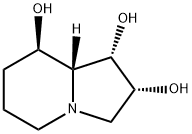Swainsonine , ≥98% , 72741-87-8
Synonym(s):
(1S,2R,8R,8aR)-1,2,8-Octahydroindolizidinetriol;(1S,2S,8R,8aR)-Trihydroxyindolizidine, 8aβ-Indolizidine-1α,2α,8β-triol;Swainsonine, Swainsona canescens - CAS 72741-87-8 - Calbiochem
| Pack Size | Price | Stock | Quantity |
| 1MG | RMB1199.20 | In Stock |
|
| 5MG | RMB4319.20 | In Stock |
|
| others | Enquire |
PRODUCT Properties
| Melting point: | 148-149°C |
| Boiling point: | 353.3±21.0 °C(Predicted) |
| Density | 1.38±0.1 g/cm3 (20 ºC 760 Torr) |
| storage temp. | -20°C |
| solubility | H2O: soluble1mg/mL |
| pka | 14.01±0.60(Predicted) |
| form | lyophilized powder |
| color | white to faint yellow |
| biological source | synthetic |
| Water Solubility | Soluble to 50 mM in water |
| BRN | 4175740 |
| Stability: | Stable for 1 year from date of purchase as supplied. Solutions in DMSO, ethanol or distilled water may be stored at -20°C for up to 3 months. |
| CAS DataBase Reference | 72741-87-8 |
Description and Uses
Swainsonine (72741-87-8) is a naturally occurring alkaloidal toxin found in locoweed. Inhibits the biosynthesis of complex glycoproteins by inhibition of Golgi mannosidase II (IC50 = 0.2 mM).1 Inhibits growth and potentiates the cytotoxic effect of taxol in hepatocellular carcinoma in vivo.2 Induces apoptosis in a variety of cell types including cerebral cortical neurons.3 Impairs adult neurogenesis and spatial learning and memory.4? Abrogation of complex glycosylation by swainsonine results in strain-and cell-specific inhibition of prion replication.5 Induces lysosomal storage disease in farm animals.6
Swainsonine is an indolizidine alkaloid naturally found in certain plants including locoweed that inhibits N-linked glycoside hydrolases, preventing the processing of asparagine-linked glycoproteins. It reversibly inhibits lysosomal α-mannosidase and Golgi α-mannosidase II (IC50 = 0.2 μM). Swainsonine is used to study the role of N-linked glycosylation in cellular processes and has been shown to have antiproliferative and antimetastatic effects of cancer cells in culture and in mice. The inhibition of α-mannosidase activity in lysosomes produces an accumulation of partially-processed oligosaccharides and glycoproteins, giving rise to lysosomal storage disease. Swainsonine toxicity in herbivores results in a condition known as locoism, characterized by hyperactivity, aggression, stiff and clumsy gait, low head carriage, salivation, seizures, and apparent blindness, culminating in increased miscoordination, weakness and death.




